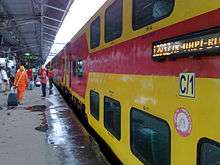Bilevel rail car
The bilevel car (American English) or double-decker train (British English and Canadian English) is a type of railcar that has two levels of passenger accommodation, as opposed to one, increasing passenger capacity (in example cases of up to 57% per car).[1] In some countries such vehicles are commonly referred to as dostos, derived from the German Doppelstockwagen.
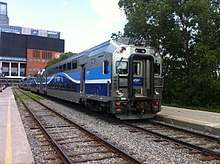

The use of double-decker carriages, where feasible, can resolve capacity problems on a railway, avoiding other options which have an associated infrastructure cost such as longer trains (which require longer station platforms), more trains per hour (which the signalling or safety requirements may not allow) or adding extra tracks besides the existing line.
Bilevel trains are claimed to be more energy efficient,[2] and may have a lower operating cost per passenger.[3] A bilevel car may carry up to about twice as many as a normal car, if structure and loading gauges permit, without requiring double the weight to pull or material to build. However, a bilevel train may take longer to exchange passengers at each station, since more people will enter and exit from each car. The increased dwell time makes them most popular on long-distance routes which make fewer stops (and may be popular with passengers for offering a better view).[1]
Bilevel cars may not be usable in countries or on older railway systems with low loading gauges. With the exception of Bombardier MultiLevel Coaches, this includes much of the rail network in the Northeastern United States, including the Northeast Corridor, as well as almost the entire British rail network. In some countries such as the UK new lines are built to a higher than the existing structure gauge to allow the use of double-deck trains in future.[4]
History
Double deck carriages date to at least as early as the second half of the 19th century. In France several hundred voitures à impériale with seats on the roof were in use by the Chemins de fer de l'Ouest, Chemins de fer de l'Est and Chemins de fer du Nord by 1870, having been in use for over 2 decades; the design was open at the sides with a light roof or awning covering the seats. In the 1860s M.J.B. Vidard introduced two-storied carriages on the Chemins de fer de l'Est, with a full body, windows, and doors; the same design lowered the floor of the lower storey to keep the center of gravity low. Vidard's carriages had a total height of 13 feet 8 inches (4.17 m) with the head height in the lower part of the carriage only 5 feet 5 inches (1.65 m); the carriages had a capacity of 80 persons (third class) in a 2 axle vehicle of 13 tons fully loaded.[5]
The Chicago, Burlington and Quincy Railroad placed bilevel cars in commuter service in the Chicago area in 1950. These were successful, and led to the Atchison, Topeka and Santa Fe Railway introducing long-distance Hi-Level cars on Chicago–Los Angeles El Capitan streamliner in 1954.[6][7]
In 1968, the four experimental double-deck power cars entered service in Sydney, Australia,[8] enabling the first fully double-deck Electric Multiple Unit passenger train in the world.
Typical design
The double-deck design usually includes lowering the bottom floor to below the top level of the wheels, closer to the rails, and then adding an upper floor above. Such a design will fit under more bridges, tunnels and power wires (structure gauge). For cost and safety, this design also minimizes car height (loading gauge) and lowers the centre of gravity.
Depending on train station platform heights, three designs can be used for entry – high platforms require use of a "split level" car design, where the doors are located on a middle level, with access into the upper or lower level branching off – with stairs or ramps going both up and down (sometimes this configuration includes a section of seating at the middle level in the entry section, with double levels only in part of the lengths of the car).[1] For low train station platforms, a "two-floor" design with level entry onto the lower floor is used. Occasionally a third, very tall "two floors over-wheel" design is used. This is a traditional single floor car "with a second story" design which, when using a low platform, requires steps up to a traditional floor height and then internal stairs up to the upper floor.
Platform height and floor height issues
There are four important height measurements above the railhead: platform height, traditional floor height, downstairs floor height and upstairs floor height. Platform height determines the level entry height for wheeled objects, such as luggage, strollers, wheelchairs and bicycles. Platform height is ideally standardized across all stations the train serves. Traditional rail car floor height matters for end doors connecting to existing single floor rail cars. Downstairs or lowest floor height is primarily determined by the thickness of the beams connecting the span between the wheels and bogies (trucks) of a rail car. The upstairs floor or highest floor height is above the lowest floor and must fit under bridges and tunnels. Level entry floor height must match the platform height. Hopefully either the traditional or downstairs floor height already matches the platform height. Despite the name "bilevel" or "double-decker", for maximum compatibility the rail car will have up to four different floor heights. High platform design (Using outside steps to avoid having a level entry from the platform) is troublesome.
Common low-platform design
Most low-platform double-decker trains have level entry onto the lower level of the car, allowing wheelchair access. There are two-floor heights (upstairs and downstairs) in these "bilevel" cars. There is a staircase between floors inside the car. Connecting doors between cars are either at the (higher) upper floor or at an intermediate level over the bogies. In the former case, connecting directly to a single level car causes drag and connecting door problems.
In the western USA, cars are of the upper-level-connection type. They use low-platform stations, because the traditional single floor trains all had exterior entry steps to maximize flexibility (emergency and temporary stops) and minimize infrastructure costs. There are no examples of two-floor platforms, so there are no platform doors on the upper floor. Car roof lines lengthwise are flat for connecting doors to the upstairs of bi-level cars. A Bombardier Amtrak Superliner car is 16 feet 2 inches (4,928 mm) tall.
Uncommon very tall design
There are several very tall bilevel cars (e.g. Colorado Railcar has 19 feet 9 1⁄2 inches (6.033 m; 6,033 mm) . They typically are described as a traditional rail car with a second story. Most of these cars serve low platforms so they have exterior steps up to the traditional "over-wheel" floor height e.g. US 51 in (1,295 mm). End doors connect at the traditional height of existing rolling stock. Some cars have upstairs end doors as well. Many of these cars also include outside balconies on either the upper or lower level. Upstairs and downstairs connect by interior stairs. These cars can fit most able people, but lack level entry. On almost all these cars the upper level consists of a full-length glass dome. Some cars are self-propelled Multiple Units so using traditional floor heights appears fixed. In towed cars it is possible to lower the downstairs floor between the wheels/bogies so that level entry is possible with more than 500 mm (19 5⁄8 in) of added headroom and interior steps from that floor to the traditional floor.
Operators
Argentina

In 2005, Emprendimientos Ferroviarios (Emfer), Trenes de Buenos Aires (TBA (Trains of Buenos Aires), National Institute of Industrial Technology and the Argentine National Government subscribed to a framework agreement to start the national designing and construction of bi-level electric trains. This was decided due to the overwhelming and increasing number of passengers using the 1,676 mm (5 ft 6 in) gauge urban Sarmiento Line, serving the centre and east of Greater Buenos Aires. The first prototype was released in 2005, but mass-production only started in mid 2008. In 2013, these coaches were retired from the line and replaced with new CSR Electric Multiple Units, though it remains unclear if the Emfer trains will be moved elsewhere in the country.[9]
In 2010, Emprendimientos Ferroviarios and Trenes de Buenos Aires presented non-engined double-decker coaches for a 100 km (62 mi) diesel interurban link between Buenos Aires and Mercedes city. Attending to different technical needs, the new coaches have only two simple non-automatic doors in the ends (instead of the two electric double doors in the middle) and were designed for low platforms.
Australia
Cheltenham_Station-3.jpg)
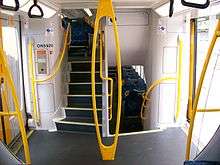
In 1964, Tulloch Limited built the first double-decker trailer cars for use in Sydney. They ran with single deck electric motor cars. After the success of the trailers, Tulloch built four experiment double decker power cars in 1968.
From 1972, more double decker multiple units were constructed by Comeng and Goninan. These are now known as the S sets. All electric suburban and interurban trains in Greater Sydney are now double deck, though the Sydney Metro uses single deck carriages. All double deck carriages have two doors per side per carriage, with a vestibule at each end at platform height. The Sydney double deck commuter trains are 14 ft 4 1⁄2 in (4,382 mm) high.
The Public Transport Corporation in Melbourne ordered a prototype Double Deck Development and Demonstration train in 1991, a modification of the successful Tangara design used in Sydney. It suffered frequent breakdowns and spent long periods out of use. It was withdrawn in 2002 and scrapped in 2006.
Canada
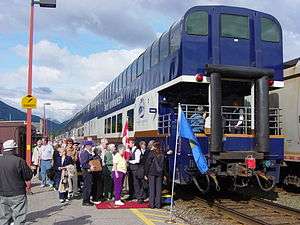
Canada's national intercity passenger railway company, Via Rail, does not currently operate any bilevel cars in its rolling stock fleet although during the late 1980s and early 1990s it had examined purchasing Superliner II equipment; this did not occur as the company endured a significant budget cut in 1990 and opted to instead rebuild the former Canadian Pacific Railway stainless steel passenger car fleet produced by the Budd Company.
Commuter train services operated by GO Transit, West Coast Express, and Exo use bi-level cars produced by Bombardier Transportation or its predecessor companies. All rolling stock for both GO Transit and West Coast Express, and part of Exo's fleet, consists of Bombardier BiLevel Coaches. However, Exo mainly operates Bombardier MultiLevel Coaches. These cars (designed in collaboration with NJ Transit; see below) were built to be operable within the restrictive structure gauge of the Mount Royal Tunnel and to accommodate the low level platforms along the Deux-Montagnes line as well as the 51-inch (1,295 mm) high platforms of Montreal Central Station. They are 14 ft 6 in (4.42 m) high. Previously, the region had a fleet of gallery cars produced in 1969 by Canadian Vickers for the Canadian Pacific Railway's "TownTrain" service; CPR's commuter rail operations in Montreal were transferred to public authorities in October 1982, and these bilevel cars have now been retired.
Older bilevel cars used in Canada are not low-floor designs and are therefore not wheelchair accessible. New bilevel cars such as the BiLevel and Multilevel coaches are wheelchair accessible, allowing operators of those cars to offer spaces for wheelchair passengers.
Some privately owned passenger rail operators also use bilevel passenger cars in their fleets: Ontario Northland's intercity passenger train Polar Bear Express operates a domed car that has two levels, however, this car is not technically considered a bilevel passenger rail car. Additionally, the rail tour company Rocky Mountaineer also uses bilevel full length dome cars built by Colorado Railcar.
China
The first bilevel train for China Railways was built by Sifang in 1958 as Dongfeng diesel multiple unit, consisting of two locomotives and four bilevel coaches. After withdrawing Dongfeng DMU from use in 1982, China Railways redeveloped double-decker trains, the first of which rolled out from Nanjing Puzhen Rolling Stock Works in 1987 as SYZ25 and SRZ25.
The carriage designations of bilevel cars in China start with "S", abbreviating "double-decker" (双层; shuāngcéng) in Chinese. Current models of double decker trains include the 25B series (zh), 25Z series (zh) and 25K series (zh). Most bilevel cars in China were built by Nanjing Puzhen Rolling Stock Works, while some bilevel coaches were built by Changchun Railway Vehicles. The types of bilevel cars including bilevel hard seat (SYZ), bilevel soft seat (SRZ), bilevel hard sleeper (SYW), bilevel soft sleeper (SRW), Bilevel dining car (SCA) and bilevel soft seat-baggage combine car (SRZXL).
Bilevel coaches are mainly used for regional services in China, like Kunming–Dali–Lijiang intercity trains in Yunnan and Shijiazhuang–Qinhuangdao express train in Hebei. Additionally, a cross-railway bureau double-deck train service is provided between Tianjin and Baoji (via Beijing West railway station).
Denmark

In Denmark, DSB began running Bombardier Double-deck Coaches in 2002. The coaches are used on Regional services on Zealand.
Finland
In Finland, VR began operating double-deck day cars in 1998. They are Finnish-designed and manufactured by Transtech in Kajaani. Each car has two entrances on the lower level of the middle section, allowing level entry from station platforms at the modern Finnish standard height of 550 mm (21.7 in).[10] The end sections of each car – and the inter-car connections – are at mid-level.
VR introduced its first double-deck sleeping cars on 1 February 2006. The two-bed cabins on the upper deck have toilets and showers while cabins on the lower deck use shared ones. Double-deck driving-trailers were introduced during late 2013 and restaurant cars in early 2014.
The double-deck cars are designed for running at higher speeds than ordinary passenger cars – up to 200 km/h (124 mph), although the upper limit was later reduced for trains entering tunnels. The cars are frequently operated in all-double-deck InterCity trains (known as IC2) with at-seat power supply for laptops and wireless LAN internet connection.
France

The Chemin de fer de l'État in France ran voitures à 2 étages double-deck suburban coaches from 1933. Its successor, the SNCF, has been running VB2N double-decker coaches since 1975; VB2N were introduced from 1975 as a replacement of the État cars.
Since 1982, SNCF has been running double-deck RER trains. And since 1996, SNCF runs double-deck TGV cars on heavily used high-speed services, such as on the Paris-Lyon-Marseille line. Many suburban rail, regional rail and high-speed services are operated by double-deck DMUs, EMUs, coaches and TGV. The TGV Duplex are the fastest double-decker trains in the world with a commercial top speed of 320 km/h. Specially tuned trainset 4402 also holds the world speed record for conventional trains, reaching 574.8 km/h in 2007. The French loading gauge dictates that the double-deck cars have a maximum height of 4.32 m (14 ft 2 1⁄8 in).
Hong Kong
MTR and formerly KCRC operate double-decker carriages with the KTT train sets on its cross-boundary route between Kowloon and Guangzhou. These cars were manufactured in Japan by Kinki Sharyo. The "Ktt" cars were used to serve between the Hung Hom and Lo Wu stations from January to May 1998, before the electrification of Guangzhou–Shenzhen Railway. The "Ktt" cars have lower bottom floor than the ordinary single-deck cars serving on the same pair of tracks.
India
In India, the Sinhagad Express was the first train to operate with double-decker carriages, followed by other trains on the Mumbai-Pune route like the Deccan Queen and the Deccan Express, although double-decker service on these routes was later discontinued. In 1979 the Flying Ranee, a passenger train between Surat and Mumbai Central on the Western Railway became the first superfast train to use double-deck cars. The first Air-Conditioned double-decker service was introduced in 2011 on the Howrah – Dhanbad Double Decker Express between Howrah station in West Bengal and Dhanbad Junction in Jharkhand[11] which was subsequently followed by Delhi Sarai Rohilla – Jaipur, Ahmedabad – Mumbai Central, Chennai Central – Bangalore, Anand Vihar (New Delhi) – Lucknow, Visakhapatnam – Vijayawada, Visakhapatnam – Tirupati[12] and Mumbai Lokmanya Tilak Terminus – Madgaon double decker expresses.
Israel
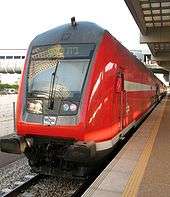
In Israel, Israel Railways began running Bombardier Double-deck Coaches in 2001. The coaches were manufactured in Görlitz, Germany.
Italy

In the 1970s, with the rise of mass commuting to the big cities the Ferrovie dello Stato have found themselves having to quickly increase the capacity of their services with Carrozze Due Piani Tipo 1979 (see it:Carrozza Due Piani). Today, double-decker coaches are also in use by private railway companies Ferrovie Nord Milano and Ferrovie del Sud Est. The types of double-decker train is circulating today in Italy are: Rock (Caravaggio), Vivalto, TAF, TSR.
Japan

In Japan, double-decker trains are used either to show better scenery, or to increase seat capacity. In Tokyo area commuter trains, double-decker cars are generally used as Green Cars, the cars with better accommodations than the regular commuter cars.
The first Japanese double-decker train appeared in 1904. It was Type 5 train of Osaka City Tram. The Kintetsu Railway 20100 Series EMUs were built in 1962 and designed for school excursion.[13] Sightseeing trains that feature double-decker carriages include the JR Shikoku 5000 series, Keihan 8000 series, JR Central 371 series, and Odakyu 20000 series RSE. The first JNR/JR double-decker trains were 200 series Shinkansen and 100 series Shinkansen, for Shinkansen lines.
JR East introduced the 215 series double-deck EMUs for Home Liner services in 1992. JR East also introduced E1 Series Shinkansen and E4 Series Shinkansen for its Shinkansen Lines; the trains are doubled decked to increase their capacities. This includes JR West 285 series EMUs for Sunrise Izumo/Sunrise Seto and JR East E26 series cars for Cassiopeia services.
Russia
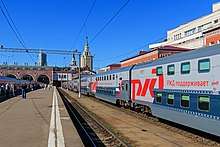
In 2012, a prototype double-decker rail carriage was made at the TVZ Tver Carriage Building Factory for the RZD Russian Railways company. This prototype carriage is a sleeping car with four-berth compartments and a total capacity of 64 passengers. Russian Railways ordered double-decker sleeper carriages from Transmashholding for the Adler-Moscow train service. As of August 2012 they were expected to be delivered in time for the 2014 winter Olympics in Sochi.[14] RZD offers low platforms for Moscow-Adler route. Train number, route, start date and types of carriages No. 103/104 Adler – Moscow 30 October 2013, Coupe, SV, 1 pair of trains per day No. 5/6 No. 7/8 St. Petersburg- Moscow 1 February 2015 1 Feb 2016 Coupe 2 pairs of trains per day No. 23/24 Moscow – Kazan 1 June 2015, Coupe, SV, 1 pair of trains per day No. 45/46 No. 69/70 (summer 2016) Moscow – Voronezh on 31 July 2015, Sessile, 1 pair of trains per day (2 pairs of trains from the summer of 2016) No. 49/50 Moscow – Samara 3 December 2015[13] Coupe, SV, 1 pair of trains per day No. 35/36 St. Petersburg- Adler 28 May 2016 29 July 2016 1 September 2016 1 October 2016, Coupe, SV 1 train in 4 days (1 pair of trains per day from October 2016)
Slovakia
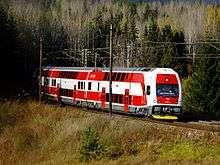
ZSSK operates 19 electric multiple units of Class 671 and 10 push-pull units of Class 951 manufactured by Škoda Transportation.[15]
These trains mostly operate services between Žilina and Košice (Žilina – Trenčín, Žilina – Košice, Košice – Prešov and some others) and around Bratislava (between Kúty and Trnava).
As of 2016 some of units 951, usually with locomotive of class 350 (Škoda 55E), are used at international train service on Bratislava (SK) – Břeclav (CZ) main line.
Sweden
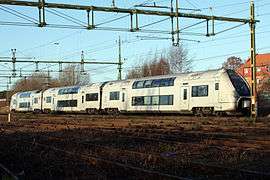
SJ AB operates 43 double-decker EMUs built by Alstom and designated class X40. The EMU comes in a two-coach version and a three-coach version. The trains are mainly used in regional trains in the areas around lake Mälaren and in the trains between Gävle and Linköping. It has a maximum speed of 200 km/h (124 mph) and is equipped with wireless internet.
Between 1966 and 1990 SJ used DMUs of class Y3 with double-decker end cars and normal cars in between. Due to the distinct humps on the endcars it was nicknamed "the camel".
Switzerland
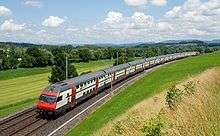
Double-decker commuter trains are used by the Zürich S-Bahn. Three types of trains are used, an older type consisting of an electric locomotive with double-decker cars, and Electric Multiple Units where the motors are on board the car. From 2010 onwards, a third type – the Stadler KISS – has entered service.
The Swiss Federal Railways also operate the IC 2000 double-decker passenger coaches in most of Switzerland for high speed InterCity and InterRegio services. After massive delays, they are introducing the Bombardier TWINDEXX from 2019 on.
Both these high speed trains feature passages on the upper level only, which makes them incompatible with single level coaches, IC2000 are however still used in combination with single level coaches during rush hours.
Ukraine
.jpg)
In 2012, as part of preparation for UEFA Euro 2012, Ukrainian Railways bought two EJ675 EMUs manufactured by Škoda Transportation. These trains are used on inter-regional (Intercity), now (from 2015-2019) services on Kharkiv – im. T. G. Shevchenko line. EJ675 electric multiple units operate at a maximum speed of 160 km/h, but are capable of achieving speeds of up to 180 km/h. Train operation is discontinued in 2019.
United Kingdom
In the United Kingdom, due to the small loading gauge, the railway system cannot accommodate double-deck trains. A modest attempt at double decking was made in 1948 on the Southern Railway with the two trains of the Bulleid 4DD class. Although innovative, with stepped compartments, where the bottoms of the upper seats are above the heads of the people on the lower level, but the feet of the people above are not,[16] the loading gauge severely restricted their use and they were removed from service in 1971.
Double-decker trams, taller than the railway loading gauge, were common in British cities. When trams were replaced between the 1930s–1960s, their replacement would be double-decker buses.
United States
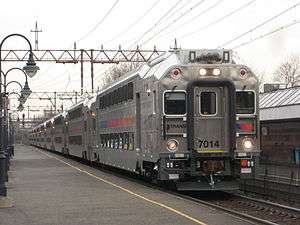
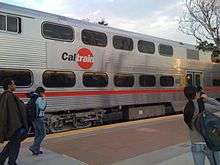
Bilevel passenger rail cars used in the United States are manufactured by Bombardier, Kawasaki, Colorado Railcar (today US Railcar), and several others, with the former two having produced the majority of the high platform "split level" commuter rail cars in use in the northeastern states.
Colorado Railcar produced bilevel DMUs and Ultra Dome passenger cars. Colorado Railcar cars measure 19 ft 9 1⁄2 in (6,033 mm) in height and have steps that enter to a lower deck that is 51 in (1,295 mm) above the rail.
Other designs, including rolling stock made by Colorado Railcar, Budd, Pullman-Standard, Bombardier and others have an entrance on the lower deck rather than an intermediate level. Amtrak Superliners are double-decker cars of this variety, with the entrance a step or so up from the lowest station platform level, or at the level of slightly higher platforms, and allow passage from car to car on the upper level.
Long-distance trains
Most of Amtrak's intercity passenger trains operating to points west of Chicago use Superliners, as do select trains east of Chicago, like the Capitol Limited and Auto Train. In addition, Alaska Railroad operates passenger trains with a mix of traditional passenger equipment and large fleets of Colorado Railcar Ultra Domes (sometimes as many as 15 in one train) owned by several major cruise ship lines.
Northeastern United States
Most passenger rail lines in the Northeast have a loading gauge that can only accommodate cars 14 ft 6 in (4,420 mm) or less in height; this is due to structure gauge restrictions such as bridges and tunnels that are too low, and may also have electrified lines overhead.
Exceptions in this region include bilevel passenger rail cars used by the Long Island Rail Road and NJ Transit, MARC and MBTA Commuter Rail, all of which were built to unique designs to clear specific structure gauge problems on those systems.[17][18] The bilevels used on LIRR, MARC, and MBTA were built by Kawasaki Rail Car, Inc., while the bilevel cars used by NJ Transit were built by Bombardier Transportation.[19][20] Recently Rotem has built additional new cars of a similar design for MBTA.
In each of these agencies' bilevel cars, two levels are present between the trucks of the car. At each end, stairs lead from both levels to a common floor which is located at standard height over the trucks. All LIRR bilevel passenger rail cars have two wide quarter-point doors on each side, for high level platforms only. The bilevel cars used by NJ Transit and Exo have four doors on each side, two quarter-point doors at high level platform height and one at each end vestibule, with traps used to reach low level platforms. The bilevel cars used by MBTA have side doors with traps at each end vestibule. MARC operates both of the latter two types of cars.
California
Due to the typically-generous clearances on California railroads due to freight railroads expanding clearances to accommodate double-stacked containers, bilevel cars are common in the state. The California Department of Transportation owns 88 California Cars, which are based on the Superliner body shell, but with high-density interiors suitable for corridor trains. These cars, along with 39 owned directly by Amtrak, are dedicated to state-subsidized Amtrak California routes including the San Joaquin, Capitol Corridor and Pacific Surfliner routes.[21] The Surfliner also serves Amtrak's California lines.
Metrolink which serves Southern California also has 137 active Bombardier Bi-level Coaches (Sentinel Fleet) and 137 Hyundai Rotem Bi-level cars (Guardian Fleet). Caltrain in the Bay Area uses bi-level coaches as well.
Florida
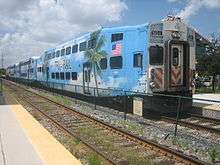
Southeast Florida's Tri-Rail service between Miami and West Palm Beach uses Bombardier bi-level coaches similar to those of Ontario's GO Transit.
Illinois
Metra's bilevel passenger cars are known as "gallery cars" (see below) as there is an open space between the two sides of the upper deck, allowing ticket collectors to check tickets on both levels from the bottom level. Chicago does not have the loading gauge problems that affect passenger rail lines in most northeastern states because it has very few railroad tunnels for the lines of these passenger trains except for a brief distance in the city. Former Metra coaches are also used by the Virginia Railway Express and Nashville's Music City Star.
Massachusetts
The MBTA is the public agency responsible for operating most public transportation services in Greater Boston, Massachusetts. Earlier modes of public transportation in Boston were independently owned and operated; many were first folded into a single agency with the formation of the Metropolitan Transit Authority (MTA) in 1947. The MTA was replaced in 1964 with the present-day MBTA, which was established as an individual department within the Commonwealth of Massachusetts before becoming a division of the Massachusetts Department of Transportation (MassDOT) in 2009. Not as yet connected directly by commuter rail, the pair of major intermodal passenger rail stations in Boston connected to the MBTA Commuter Rail network comprise North Station, a major transportation hub located at Causeway and Nashua Streets in Boston, Massachusetts, United States, as one of the pair of inbound terminals for Amtrak and MBTA Commuter Rail trains; and South Station, the largest railroad station and intercity bus terminal in Greater Boston and New England's second-largest transportation center after Logan International Airport.
New Mexico
The New Mexico Rail Runner Express utilizes bilevel cars on its route from Santa Fe, New Mexico to Belen, New Mexico.
Other countries
Asia
In Iran, the Tehran-Hashtgerd suburban commuter line is served with electric push-pull hauled trainsets with double-decker carriages manufactured by Wagon Pars in Iran.
In the Philippines, bilevel trams ran on the Tranvias of Manila. These were push–pull trains carried by lightweight steam locomotives. There were also double-deck sleeping cars used on the Bicol Express until 2014.
In South Korea, ITX-Cheongchun, the express train of Korail uses double-decker cars along with single-decker ones.
In Vietnam, the train operated by Vietnam Railways between Saigon and Phan Thiet occasionally carries double deck carriages to fulfil extra demand.
Europe
In Germany, Bombardier's double-deck rail cars are also used extensively on suburban trains by the DB. The same rail cars serve some of the routes on the Israel Railways network, hauled by diesel locomotives and include electric generators housed in the control car.
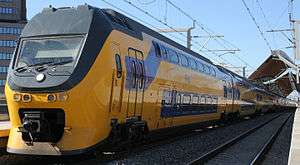
In the Netherlands, there are two types of double-deck trains in use, the VIRM and the DDZ. The VIRM, is an example from the Netherlands, of High platform (split level) double-decker cars. It is one step up from the station platform to the entrance, and from there seven steps upstairs or four steps downstairs. There are two retired types of double-deck trains, the DDM-1 and the DD-AR who were retired from regular service on the 15th of December 2019.
In Portugal, CP Urban Services and Fertagus use double-deck trains around Lisbon in commuter rail services.
In Spain, several lines of Cercanías (Renfe's commuter rail service) use double-deck trains.
In Romania, some regional trains use bilevel cars.[22][23] Over 200 bi-level cars were imported from Waggonbau Görlitz starting with the early 1980s. [24]
Gallery cars
Because of the two levels being separate on most cars, there is a physical limitation on a single conductor, as it can be difficult for him or her to verify, collect payment and sell tickets to passengers on the two levels. In 1955, the St. Louis Car Company came up with a solution in the form of the "gallery" car design, which features upper levels, which are "mezzanines" or "balconies" running along both sides of the car, with an open area between them.[25] Most gallery cars have four separate galleries with four separate stairwells to the main level (one on each side, split in the middle by the central vestibule).[26]
The split balcony enables conductors walking along on the lower level to easily reach up and punch or validate tickets of the passengers seated on the mezzanine level. Passengers can place their tickets in clips along a lengthwise panel, located slightly above the conductor's head and within easy reach. The conductor can then check all tickets and move to the next car.
Most gallery cars have a low first step at the vestibule entrance to the car, which is 14 5⁄8 inches (371 mm) above the head of the rail. Metra Electric Highliner (now retired[27]) and Highliner II, however have high-level entrances for the high-level platforms on that line. NICTD South Shore Line Bi-Levels are similar to the Metra Highliner IIs but have entrances at the end of the rail car opposite the cab with a stairwell and trap doors for low-level platforms and a station stop in the middle of 11th street in Michigan City, Indiana.
The Chicago, Burlington, and Quincy was the first to receive gallery cars, built by the Budd Company in 1950, and then North Western, followed by the Southern Pacific Railroad. Today, such cars are still used by Metra in and around Chicago, Caltrain along the west side of San Francisco Bay, Virginia Railway Express in Northern Virginia, Nashville's Music City Star and the NICTD's South Shore Line from Chicago to South Bend, Indiana. Chicago's commuter rail system is currently receiving new versions of these cars built by Nippon Sharyo.[28] Caltrain, the San Francisco peninsula commuter rail service, has recently overhauled its fleet.
See also
References
- "L.I.R.R. May Add Double-Decker Coaches". The New York Times. 21 September 1988. Retrieved 11 January 2011.
- "How green are our trains? We don't know, AMT says". The Montreal Gazette. 10 January 2011. Archived from the original on 14 January 2011. Retrieved 11 January 2011.
- "Via Rail begins experiment with Amtrak bi-level train". The Phoenix. 21 September 1984. Retrieved 11 January 2011.
- "Double-decker trains may ease overcrowding". The Telegraph. 30 December 2005. Retrieved 11 January 2011.
- "Two-storied railway carriages" (PDF), Engineering, 9: 377, 27 May 1870
- Flick, Michael W.; Kogan, Dennis (1999). "Santa Fe's Hi-Level Passenger Cars". Warbonnet. 5 (3): 8–9. ISSN 0273-7426.
- Zimmermann, Karl (Winter 2016). "Riding High: Santa Fe's Big Move of 1956". Classic Trains. 17 (4): 52–53. ISSN 1527-0718.
- New Double Deck Suburban Electric Power Cars Calf, H.R.Australia Railway Railway Historical Society Bulletin, April 1969 pp87-91
- Bustos, Miguel (21 July 2014). "La línea Sarmiento estrena hoy nuevos trenes" (in Spanish). Trenvista. Retrieved 6 December 2018.
- "Heights" (PDF).
- Disha Kanwar (2 October 2011), "First AC double-decker train flagged off from Bengal", business-standard.com
- "City-Chennai double-decker train". The Hindu. Bangalore. 25 April 2013. Retrieved 26 April 2013.
- "近畿日本鉄道|鉄路の名優|20100系". Retrieved 16 March 2019.
- "Double-deck sleeping car on test in Russia – Railway Gazette". Railway Gazette International. Retrieved 5 August 2012.
- "Archived copy". Archived from the original on 10 September 2015. Retrieved 13 September 2015.CS1 maint: archived copy as title (link)
- "Bulleid Double Decker Society". Members.tripod.com. Retrieved 7 July 2010.
- "LIRR – Tickets, Schedules, fares, Rail – MTA". web.mta.info.
- "New Jersey Transit – Home". www.njtransit.com.
- "Inc. – Bombardier – Home". Bombardier. 2 July 2010. Retrieved 7 July 2010.
- "Kawasaki MBCR Bi-Level Cars". Archived from the original on 26 July 2010. Retrieved 8 July 2010.
- Sutton, David Warner and Harry. "On Track on Line – Amtrak Passenger Equipment Roster – Rolling Stock". www.on-track-on-line.com.
- "Vagoane etajate" (in Romanian). CFR Călători. Retrieved 8 July 2020.
- Bărbulescu, Adrian (12 April 2020). "CFR Călători a introdus vagoane suplimentare la trenurile de navetiști. LISTA garniturilor" (in Romanian). Club Feroviar. Retrieved 8 July 2020.
- "Vagoane de călători - Seria 26-26" (in Romanian). Retrieved 8 July 2020.
- "Illinois Railway Museum – C&NW; Gallery Cars". Archived from the original on 16 February 2009. Retrieved 10 February 2014.
- "More renovated gallery cars in service on Fredericksburg Line". The Free Lance-Star. 22 February 2004. Retrieved 11 January 2011.
- "Metra Electric's Original Highliner Cars Officially Retired | Metra". metrarail.com. Retrieved 9 February 2018.
- "Gallery Type Bi-Level Passenger Car for METRA (2002–)". NIPPON SHARYO. Retrieved 16 December 2015.
External links
| Wikimedia Commons has media related to |
